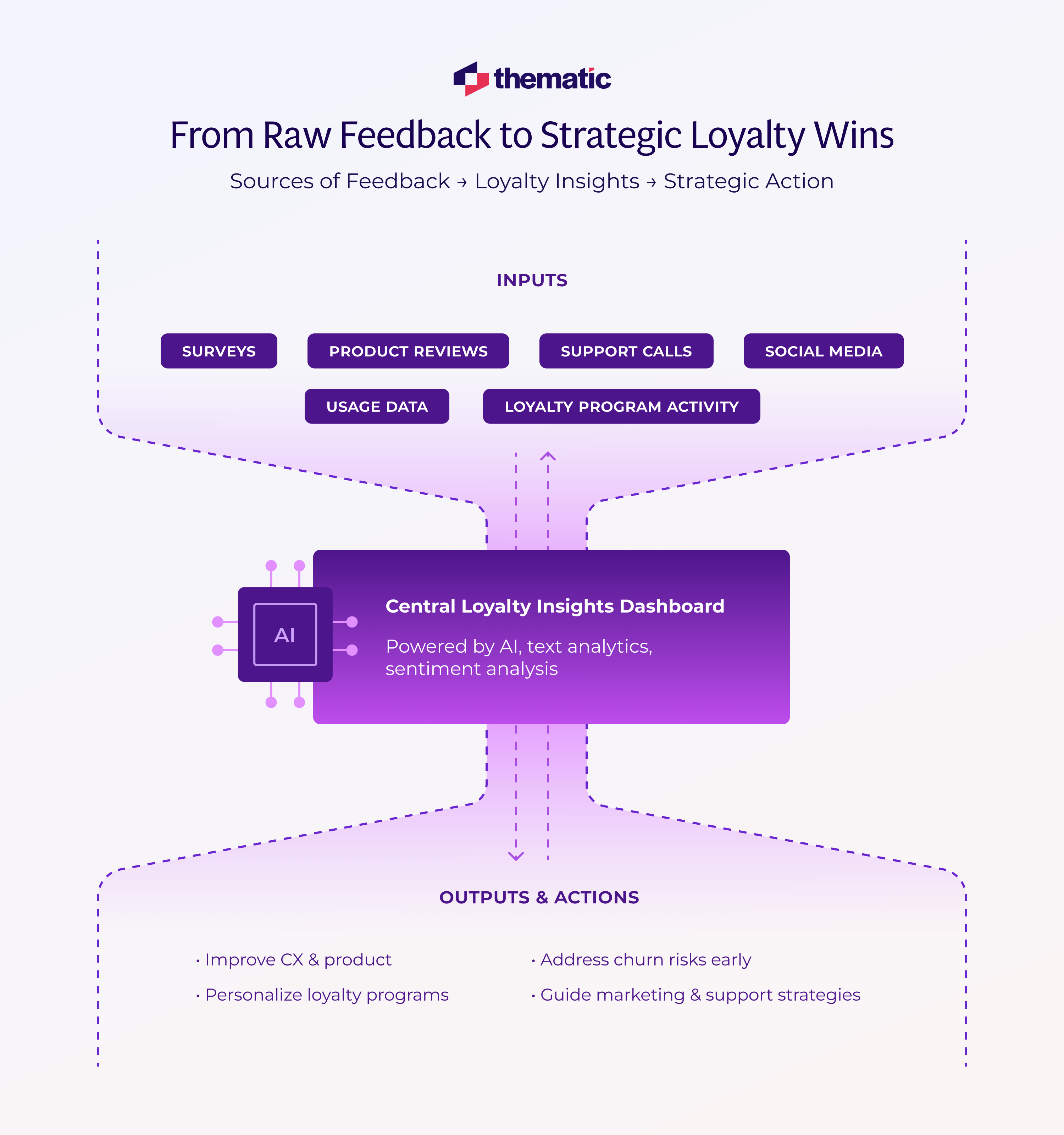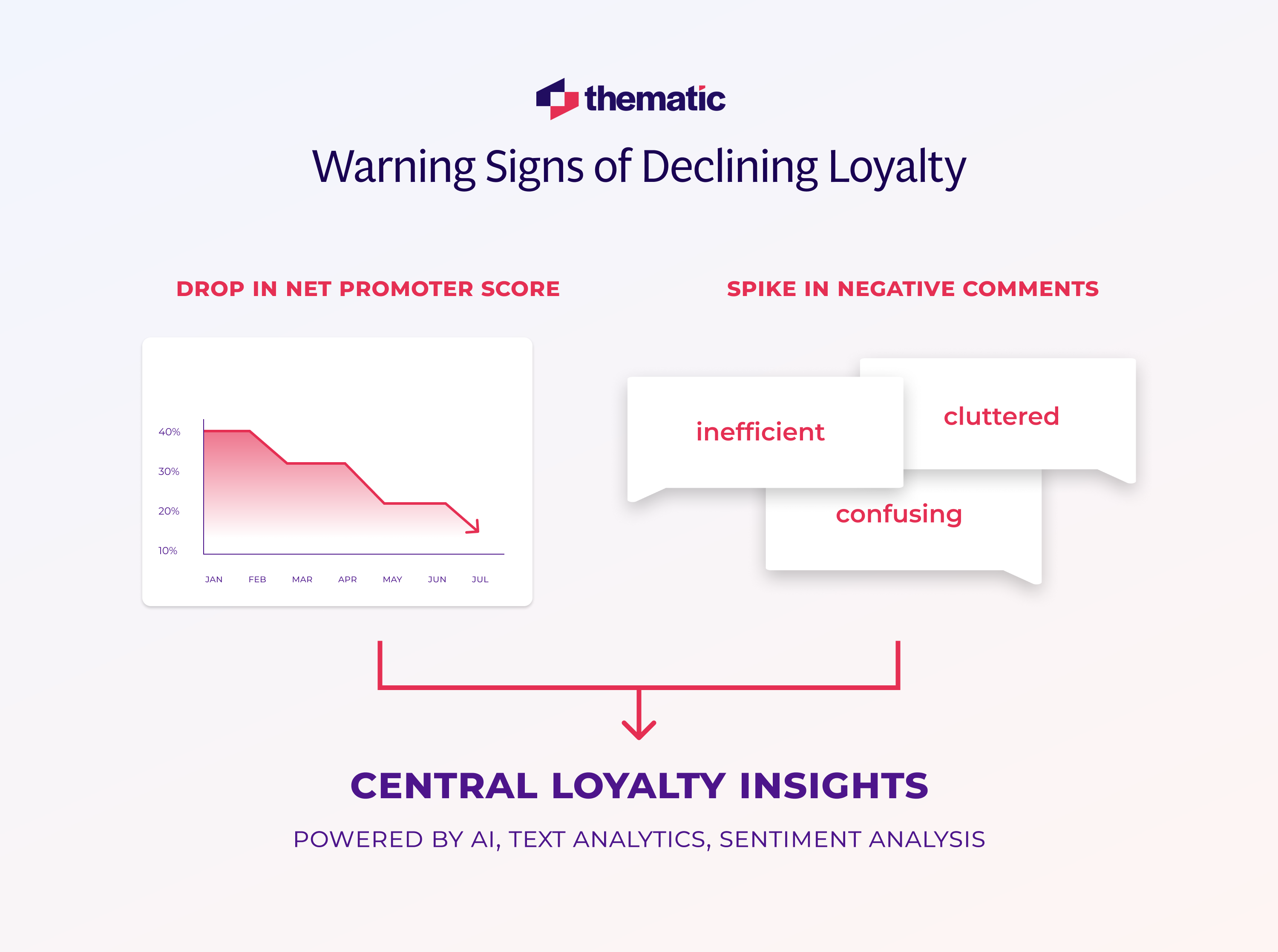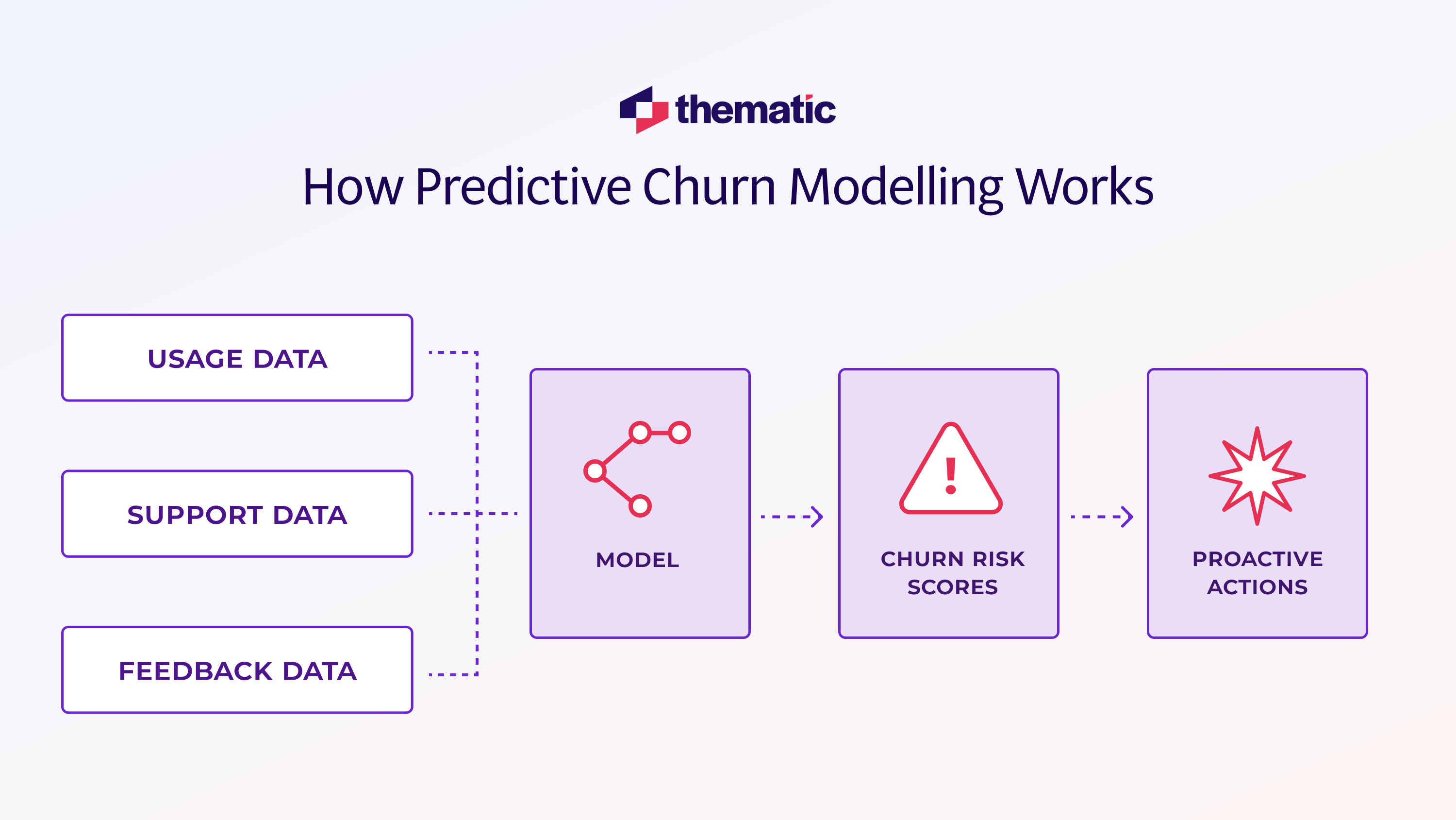
Discover what customer loyalty insights reveal—and how to act on them to boost retention and build long-term relationships.

Customer loyalty isn’t just a feel-good concept—it’s a growth engine.
As the Wyndham CMO puts it,
“Not only are our rewards members repeat visitors, they spend more when they return and they return more often… They also have a higher affinity to say to friends and family, ‘You should be staying at these brands, too.”
That’s why, in today’s market, brands are doubling down on loyalty. Nearly two-thirds of companies increased their loyalty budgets recently (averaging ~5% of revenue), even as consumers have become more willing to switch for better experiences or prices. In fact, US brand loyalty saw a 14% decline from 79% of consumers in 2022 to 68% in 2023.
We already know that understanding customer insights is important, but imagine if you can have customer loyalty insights—why customers stay loyal (or why they leave).
The stakes are high: acquiring a new customer can cost 5–7× more than keeping an existing one, and even a small boost in retention (5%) can lift profits by 25–95%.
Customer loyalty drives repeat purchases, referrals, and long-term revenue, and in this article, we’ll help you understand what your loyal customers are saying and what you can do with that knowledge.
Customer loyalty insights are the actionable truths behind why your customers stay—or leave. They go deeper than general customer feedback or surface-level metrics like NPS or churn rate. Instead, they uncover
These insights are drawn from a variety of sources:

Think of loyalty insights as both your early warning system and your optimization playbook. They can tell you that customers love your product’s ease of use, or that slow onboarding is quietly driving churn. More importantly, they give you the why—not just the what—so you can act accordingly.
To extract these insights, you need a unified approach:
Ultimately, customer loyalty insights are about discovering what matters most to your customers and using that knowledge to drive smarter, more targeted improvements. When done right, they transform disconnected data into focused action—improving experiences and strengthening relationships where it counts most.
Loyal customers tend to “show” their loyalty through behaviors and feedback. Knowing these signals helps you identify your brand champions.
If you know who your loyal fans are and why they love you (e.g., exceptional customer service or unique features), you can nurture those elements further.
Let’s talk about some common signs of strong loyalty because recognizing these signals helps you double down on what’s working.
This table outlines key loyalty behaviors, what they mean, and how to track them. Use these signals to identify your top customers and strengthen what keeps them loyal.
A high purchase frequency or consistent subscription renewal is one of the clearest signs of loyalty. When customers keep coming back on their own, it’s a signal that they’ve built trust in your product or service.
These buyers aren’t just satisfied—they’re confident you’ll deliver every time.
Loyal customers often give you the benefit of the doubt. They’re the first to try new product lines, beta features, or upsells because they trust that what you offer will meet their standards.
When you launch something new, these are the customers you want to invite first—they’ll give honest feedback and help shape early adoption.
Customers who proactively share praise—whether through surveys, reviews, or social posts—are expressing more than satisfaction. They’re signaling emotional loyalty.
These customers are often your unofficial salesforce, spreading the word without being asked.
Loyal customers tend to participate more: they open your emails, engage with your content, and join your customer communities. Some go further—defending your brand in forums or correcting misinformation online.
When customers act like unpaid ambassadors, you’ve earned a level of trust that goes far beyond transactions.
Tenure is another strong indicator. A customer who’s been with you for 5+ years and still spends regularly is demonstrating deep-rooted loyalty. They’ve seen your ups and downs—and stayed.
These long-term customers tend to be more forgiving, more invested, and more willing to offer detailed feedback that helps you improve.
Spotting the Warning Signs of Declining Loyalty
Just as important as happy signals are the red flags that loyalty may be fading. Customer loyalty can erode quietly long before a customer actually leaves – but if you know what to watch for, you can intervene early. Here are key warning signs:
When regular customers stop engaging, something’s up. Maybe they used to log in daily, but now it’s weekly—or not at all. Maybe they’ve skipped a purchase or paused their subscription. In SaaS, this often shows up as a gradual dip in feature usage before a cancellation. In retail, you might notice reduced order frequency or cart abandonment.
These behavior changes are early warning signs. If you track usage trends, you can flag disengagement before it becomes churn—and reach out with win-back efforts or personalized support.
A sudden drop in NPS or CSAT among a segment—like premium customers—can reveal a brewing problem, even if your overall scores look steady.
Take DoorDash: when their merchant NPS fell, they investigated. Feedback showed users were frustrated with their menu manager tool. The interface was clunky and slowed down their workflow. By fixing it, DoorDash reversed the satisfaction dip and retained loyalty. The lesson? Don’t just monitor scores—analyze the why behind the change.
Even if a customer doesn’t contact you directly, they may express frustration in open-text survey responses, reviews, or social posts.
Watch for rising use of words like “disappointed,” “frustrating,” or “not what it used to be.” If support teams report more tickets on the same issue, or your sentiment analysis shows a decline from 80% to 60% positive in a key area, that’s your cue to act.
Sometimes customers do show their intentions clearly:
These are signs the customer is inching toward the exit. Pay close attention to what changed in their experience or perception.
When customers start saying “this isn’t worth the price anymore” or mention switching to a competitor, your value proposition is at risk.
One study found that 53% of consumers switched brands after just one bad experience, and 60% would switch for a better price if the perceived value isn’t there. If you hear frequent grumbles about cost or comparisons to competitors, don’t ignore it—it’s a loyalty leak in progress.

When it comes to loyalty, what gets measured gets managed. But you need to make sure you’re tracking the metrics that truly reflect loyalty—not vanity stats, but meaningful KPIs that indicate whether customers will stick around.
Here are some of the most important metrics and how they inform your loyalty insights:
These are your top-level indicators of whether customers are sticking around—or quietly disappearing.
Track these over time, but more importantly, segment them (by product, tenure, geography, etc.). If churn is rising in one region or among new customers, that’s your cue to investigate.
A classic loyalty proxy that asks: How likely are you to recommend us?
Scoring:
Formula: % Promoters − % Detractors = NPS
NPS is easy to communicate but only powerful when paired with qualitative feedback (e.g., "What do Detractors complain about most?")—that’s quantitative and qualitative data working together. It’s also useful for setting goals like:
“Improve NPS by 10 points by resolving top complaints from Detractors.”
CSAT scores satisfaction with a specific interaction (e.g., after a support call or checkout). Usually a 1–5 or 1–10 scale.
It’s transactional rather than holistic—but it highlights specific loyalty risks. For example:
Stage
CSAT Score
Loyalty Risk
Onboarding
95%
✅ Low
Cancellation Flow
60%
⚠️ High
Low CSAT at key touchpoints can weaken overall loyalty even if the product is great.
How easy was it for the customer to get what they needed?
Customers will forgive mistakes—but not friction. If CES is trending high (high effort), that’s a sign of poor usability, confusing processes, or clunky service.
Use CES to uncover gaps traditional satisfaction metrics might miss, like:
“Support was helpful—but I had to talk to 3 reps before getting the answer.”
These metrics directly tie to the financial impact of loyalty.
Track LTV by segment (e.g., loyalty program members vs. non-members). A low repeat purchase rate (e.g., only 30% of first-timers buy again) is a classic leaky bucket—fixing that can dramatically improve ROI.
These are your early indicators of deeper loyalty behaviors:
While not core KPIs, they highlight momentum and help flag at-risk users before they churn.
If you have a rewards or membership program, go beyond tracking signups:
Low redemption may suggest uninspiring rewards; high engagement indicates the program is boosting loyalty. Ask: Is this program actually changing behavior?
Use this quick-reference table to understand what each loyalty metric measures and how it helps guide your customer retention strategy.
Wouldn't it be great if you knew which customers might leave before they do? That's what predictive analytics makes possible. It uses historical customer data—such as demographics, purchase history, engagement, support interactions, and feedback—to anticipate churn, allowing proactive management rather than reactive responses.
Here's how predictive analytics can help:
Real-world examples illustrate its power:

Not every unhappy customer is worth chasing—but some definitely are. Predictive analytics helps you:
It also works with unstructured data—like customer comments. If “too expensive” comes up frequently in a customer’s feedback, that theme can feed into their risk profile.
You don’t need a massive data science team to begin. Tools like Thematic offer built-in predictive features, including churn forecasting and trend detection.
To implement:
But prediction alone isn’t enough—you need clear playbooks to act on these insights.
Define cross-functional responses—like targeted offers or personal outreach—to quickly address at-risk customers. By anticipating churn and intervening early, predictive analytics boosts retention and builds long-term loyalty.
Think of predictive analytics like a loyalty weather forecast. If a storm’s brewing, you don’t wait—you prepare, or better yet, prevent it altogether. The best companies don’t wait for a quarterly report to reveal churn—they’re already reaching out, solving issues, and rebuilding trust.
Being proactive, not just reactive, is what turns insights into impact.
The short answer? Everyone.
While a central insights or CX group may coordinate the effort, the responsibility for acting on those insights spans your entire organization. Why? Because what drives or damages loyalty often cuts across product, marketing, support, and operations. The best companies treat loyalty as a shared KPI—and make sure everyone can access and act on the insights that matter.
Instead of siloed reports, build accessible dashboards or portals where teams can filter insights based on their focus—e.g., product can dive into feature feedback, while support monitors complaints.
Customer insights platforms and other feedback tools like Thematic make this easier by letting teams explore real-time feedback without needing to wait on analysts. As LendingTree puts it: “Teach them to fish, rather than give them the fish.”
Here’s how different teams typically contribute:
To turn insight into action, assign ownership clearly: who will address the issue or double down on what’s working? And with tools like Thematic’s Generative AI, even non-analysts can ask, “Why are customers frustrated this month?” and get immediate, usable answers.
In short: Everyone owns loyalty insights. And the teams best positioned to act—whether it’s fixing bugs, rewriting messaging, or improving training—should take the lead. This kind of shared accountability is how insights move from reports to real impact.
Loyalty insights are your roadmap to deeper customer relationships—but only if you act on them.
From support tickets to social sentiment, each signal tells you what matters most to your customers. Use that knowledge to fix pain points, personalize experiences, and prevent churn before it happens.
Share insights across teams, close feedback loops quickly, and make improvements that customers can feel.
Loyalty isn’t a one-time win—it’s earned again and again.
Treat every insight as an opportunity to build trust. Because when customers feel heard, they stick around—and they tell others. That’s how loyalty becomes your competitive edge.
Ready to start gathering customer loyalty insights? Experience feedback analysis in action on your own data with a demo of Thematic.
Join the newsletter to receive the latest updates in your inbox.